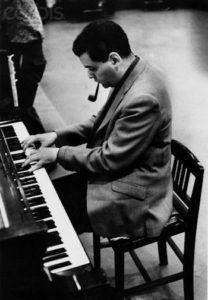
George Russell
*George Russell was born on this date in 1923. He was a Black jazz pianist, composer, arranger, and theorist.
George Allen Russell was born in Cincinnati, Ohio, to a white father and a Black mother. Later, he was the adopted only child of a nurse and a chef on the B&O Railroad, Bessie and Joseph Russell. Young Russell sang in the choir of the African Methodist Episcopal Church and listened to the Kentucky Riverboat music of Fate Marable. At age seven, he made his stage debut, singing "Moon Over Miami" with Fats Waller.
Surrounded by the music of the Black church and the big bands that played on the Ohio Riverboats, and with a father who was a music educator at Oberlin College, he started playing drums with the Boy Scouts and Bugle Corps, receiving a scholarship to Wilberforce University, where he joined the Collegians, a band noted as a breeding ground for great jazz musicians including Ben Webster, Coleman Hawkins, Charles Freeman Lee, Frank Foster, and Benny Carter. Russell served in that band simultaneously with another noted jazz composer, Ernie Wilkins.
When called up for the draft at the beginning of World War II, he was quickly hospitalized with tuberculosis, where a fellow patient taught him the fundamentals of music theory. After his release from the hospital, he played drums with Benny Carter's band but decided to give up drumming as a vocation after hearing Max Roach, who replaced him in the orchestra. Inspired by hearing Thelonious Monk's "Round Midnight," Russell moved to New York in the early 1940s, where he became part of a coterie of young innovators who frequented the 55th Street apartment of Gil Evans. This clique included Miles Davis, Charlie Parker, Gerry Mulligan, and John Lewis, who later became the music director of the Modern Jazz Quartet.
In 1945–46, Russell was again hospitalized for tuberculosis for 16 months. Forced to turn down work as Charlie Parker's drummer, during that time, he worked out the basic tenets of what was to become his Lydian Chromatic Concept of Tonal Organization, a theory encompassing all of equal-tempered music that has been influential well beyond the boundaries of jazz. Russell published the first edition of his book in 1953 while he worked as a sales clerk at Macy's. At that time, Russell's ideas represented a crucial step in the model of music developed by John Coltrane and Miles Davis, as seen in their classic recording, Kind of Blue, and served as a beacon for other modernists, such as Eric Dolphy and Art Farmer.
While working on the theory, Russell also applied its principles to composition. His first famous composition was for the Dizzy Gillespie Orchestra, the two-part "Cubano Be, Cubano Bop" (1947) and part of that band's pioneering experiments in fusing bebop and Cuban jazz elements; "A Bird in Igor's Yard" (a tribute to both Charlie Parker and Igor Stravinsky) the following year. Also, a lesser-known but pivotal work arranged by Russell was recorded in January 1950 by Artie Shaw, entitled "Similau," which employed techniques similar to those used for Gillespie. Russell began playing piano, leading a series of groups. He was to record several impressive albums over the next several years, sometimes as a primary pianist.
In 1957, Russell was one of six jazz musicians commissioned by Brandeis University to write a piece for their Festival of the Creative Arts. He wrote a suite for orchestra, All About Rosie, which featured Bill Evans among other soloists and has been cited as one of the few convincing examples of composed polyphony in jazz. Members of the orchestra on his 1958 extended work, New York, N.Y., included Bill Evans, John Coltrane, Art Farmer, Milt Hinton, Bob Brookmeyer, and Max Roach, among others, and featured wrap-around raps by singer/lyricist Jon Hendricks. Between 1960 and 1963, the Russell Sextet featured musicians like Dave Baker and Steve Swallow and memorable sessions with Eric Dolphy and singer Sheila Jordan (their bleak version of "You Are My Sunshine" on The Outer View (1962). He received a MacArthur Foundation "genius" grant in 1989.
In his career, Russell also received the 1990 National Endowment for the Arts American Jazz Master Award, two Guggenheim Fellowships, and the British Jazz Award. He has been elected a Foreign Member of the Royal Swedish Academy of Music, won the Oscar du Disque de Jazz Award, the Guardian Award, the American Music Award, six NEA Music Fellowships, and numerous others. He taught worldwide and was a guest conductor for German, Italian, Danish, Finnish, Norwegian, and Swedish radio groups.
He is considered one of the first jazz musicians to contribute to general music theory with a theory of harmony based on jazz rather than European music in his book Lydian Chromatic Concept of Tonal Organization (1953). According to his publicist, George Russell died of complications from Alzheimer's disease in Boston, Massachusetts, on July 27, 2009.